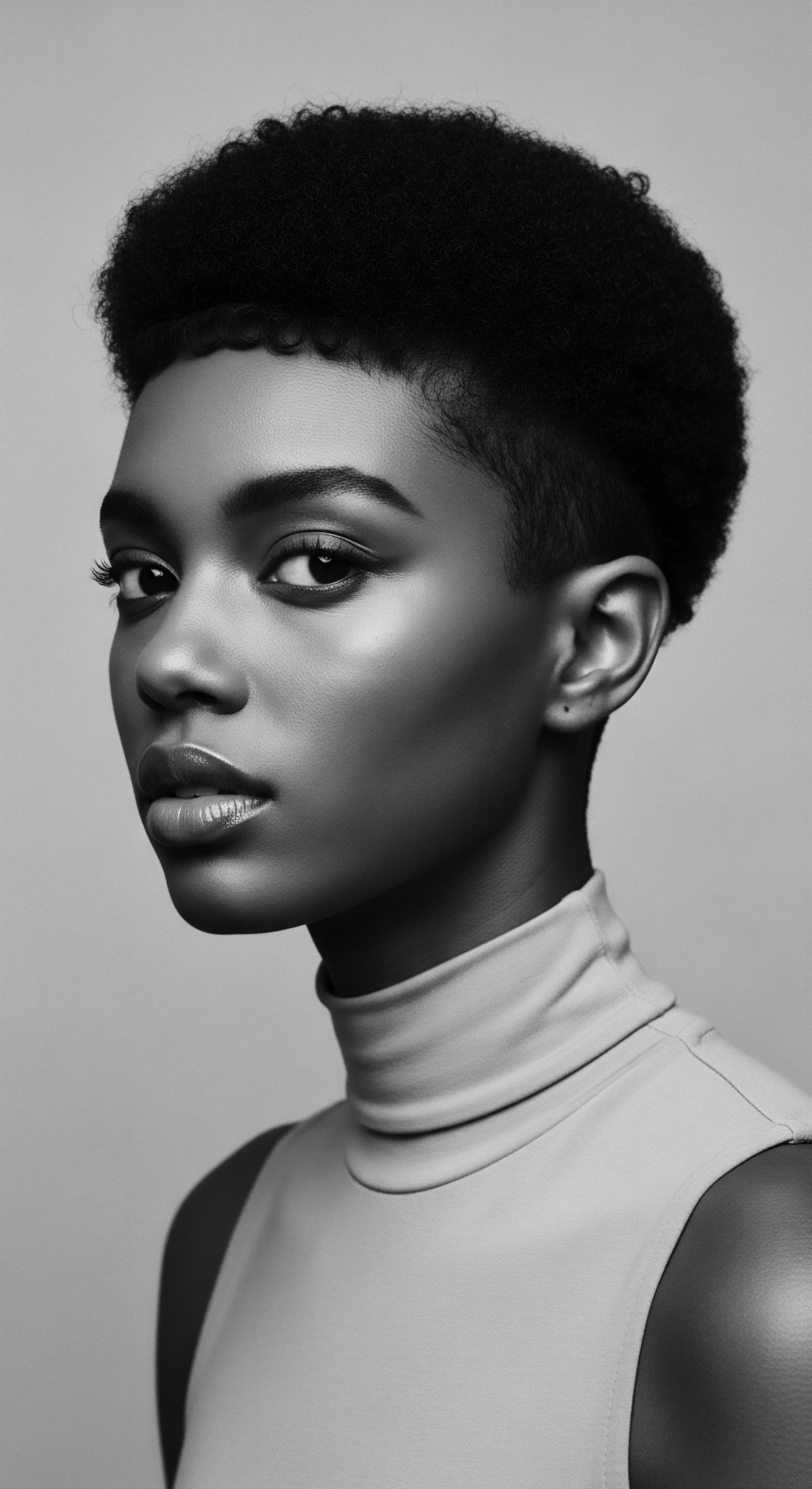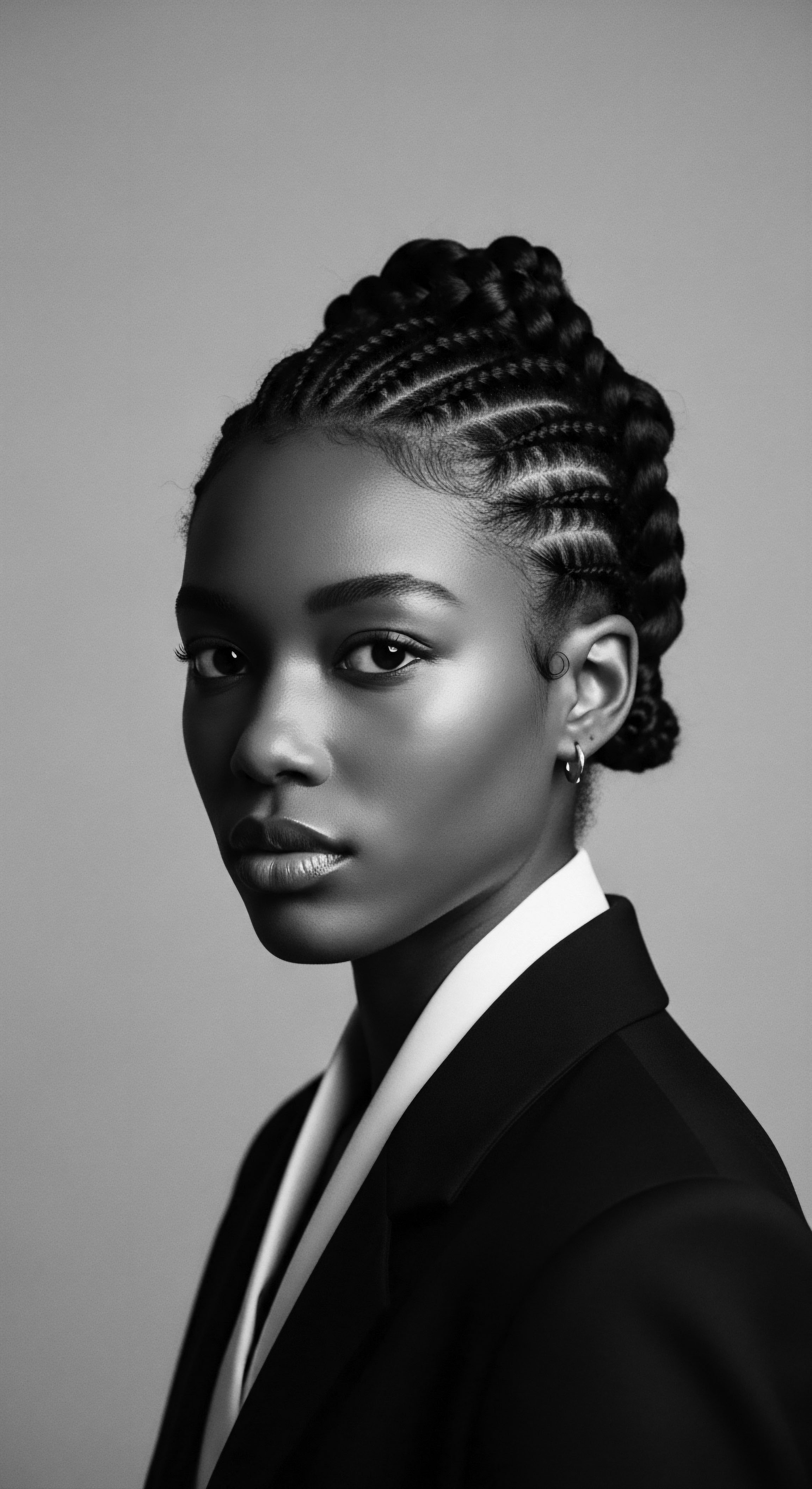
Fundamentals
The journey of textured hair, a lineage of unparalleled strength and beauty, carries within its very coils and strands a chronicle of adaptation, resilience, and profound identity. Within this living archive, the concept of Chemical Straightening emerges not merely as a technical process but as a significant chapter, a practice whose definition extends far beyond its chemical composition. At its simplest, Chemical Straightening denotes a process employing chemical agents to alter the natural curl pattern of hair, rendering it less curly or entirely straight.
This alteration is achieved by manipulating the hair’s inherent protein structure, specifically the disulfide bonds that grant textured hair its distinctive shape. For those new to this terrain, grasping this fundamental explanation serves as the initial step into a deeper understanding of its implications, particularly for hair with a rich, ancestral heritage.
The elemental explanation of Chemical Straightening begins with the hair shaft itself, a marvel of biological engineering. Each strand of hair, a fibrous protein filament, contains a cortex where keratin proteins are arranged. The unique curvature of textured hair arises from the uneven distribution of these proteins and the shape of the hair follicle, which is typically oval or elliptical. Chemical Straightening aims to reshape this inherent architecture.
The process involves applying a strong alkaline solution, often containing sodium hydroxide or guanidine hydroxide, to the hair. This solution penetrates the cuticle, the outermost protective layer, and reaches the cortex. Once inside, it initiates a reaction that breaks a significant portion of the disulfide bonds. These bonds, like tiny bridges, hold the keratin chains together, dictating the hair’s curl and wave. When these bridges are broken, the hair’s structure becomes pliable, allowing it to be combed into a straighter configuration.
After the bonds are broken and the hair is mechanically straightened, a neutralizer, often a hydrogen peroxide-based solution, is applied. This second step is crucial; it re-forms new disulfide bonds in the hair’s newly straightened shape, locking the altered structure into place. Without neutralization, the hair would remain in a fragile, altered state, susceptible to breakage and further damage. This basic delineation of the chemical process, while seemingly straightforward, carries with it layers of historical and cultural meaning, especially when viewed through the lens of textured hair heritage.
Chemical Straightening, at its core, is a chemical alteration of hair’s natural curl pattern, a process that has woven itself into the fabric of textured hair history.
Historically, the aspiration for smoother hair forms was not born in a vacuum; it has roots in diverse cultural practices predating modern chemistry. Ancient civilizations, across various continents, employed natural substances and mechanical methods to alter hair texture, seeking different aesthetic or ceremonial expressions. The desire to modify hair’s appearance, whether for spiritual, social, or personal reasons, is a recurring theme in human history.
The advent of chemical agents, however, introduced a new dimension to this long-standing practice, offering a more permanent and dramatic transformation. The meaning of this transformation, for communities with a deep heritage of textured hair, has always been complex, reflecting both personal choice and broader societal currents.
Understanding the fundamentals of Chemical Straightening therefore requires acknowledging its dual nature ❉ a scientific procedure and a culturally charged practice. Its presence in the hair care lexicon for Black and mixed-race communities is a testament to its enduring, albeit often debated, significance.
- Disulfide Bonds ❉ These are the primary chemical links within the hair’s keratin structure, responsible for its strength and natural curl. Chemical straightening specifically targets these bonds for alteration.
- Alkaline Agents ❉ Compounds like sodium hydroxide or guanidine hydroxide are the active ingredients in chemical straighteners, initiating the bond-breaking process.
- Neutralization ❉ A vital step where new bonds are re-formed in the hair’s straightened configuration, stabilizing the altered structure and completing the process.

Intermediate
Stepping beyond the foundational concepts, an intermediate understanding of Chemical Straightening requires a more granular examination of its historical evolution, the differing chemical formulations, and the profound societal currents that shaped its adoption within textured hair communities. The interpretation of Chemical Straightening shifts from a mere technical act to a complex cultural phenomenon, deeply intertwined with identity, perception, and ancestral legacies. This deeper exploration unveils how the very essence of hair care practices, including straightening, became a mirror reflecting broader historical narratives for Black and mixed-race individuals.
The trajectory of Chemical Straightening, particularly in the context of Black hair, is inseparable from the early 20th century’s burgeoning Black beauty industry. Pioneers like Madame C.J. Walker, while celebrated for empowering Black women through entrepreneurship, also contributed to the popularization of hair straightening methods, primarily through the use of hot combs and pressing oils.
This initial wave of thermal straightening laid a groundwork for the later acceptance and eventual dominance of chemical alternatives. The demand for smoother, more manageable hair was not solely an internal aesthetic preference; it was significantly influenced by prevailing Eurocentric beauty standards that permeated society, impacting opportunities and social acceptance.
The introduction of chemical relaxers offered a more enduring solution than thermal pressing, promising a lasting straightness with less daily effort. Early formulations, often referred to as “lye relaxers,” contained sodium hydroxide as the active ingredient. This powerful alkali is highly effective at breaking disulfide bonds, but its potency also presented considerable risks of scalp burns, irritation, and hair damage if not applied with extreme care. The widespread use of these strong chemical agents, despite their potential for harm, speaks to the immense societal pressure and the deep-seated desire for hair that conformed to a specific aesthetic.
The historical trajectory of chemical straightening within Black communities reflects a complex interplay of evolving beauty standards, entrepreneurial spirit, and the enduring quest for hair manageability.
A later development saw the introduction of “no-lye” relaxers, typically formulated with guanidine hydroxide. While still alkaline and capable of breaking disulfide bonds, these were marketed as gentler alternatives, often appealing to individuals with sensitive scalps or those seeking less harsh treatments. However, the designation “no-lye” could be misleading; these formulations still contained strong chemical agents, albeit different ones, and often left calcium deposits on the hair, leading to dryness and brittleness over time. The continuous innovation in chemical formulations, from lye to no-lye and beyond, illustrates a persistent effort to balance effectiveness with reduced damage, a balance often elusive in the pursuit of dramatic textural alteration.
The societal meaning of straightened hair within Black and mixed-race communities has been a subject of extensive discussion and varying interpretations. For some, it represented a pathway to assimilation, a means of navigating a world where natural textured hair was often stigmatized or deemed unprofessional. For others, it was a personal choice, a stylistic preference, or a practical solution for hair management.
This dual perspective highlights the complex agency individuals exercised within the constraints of societal expectations. The historical significance of chemical straightening thus extends beyond chemistry; it becomes a lens through which to examine racial identity, self-perception, and the evolving definitions of beauty.
The practice also fostered a vibrant salon culture, transforming hair care into a communal ritual. Black-owned salons became vital social hubs, places of shared experiences, advice, and solidarity, where the application of chemical straighteners was a central service. This communal aspect adds another layer to the understanding of chemical straightening, moving it beyond a mere product application to a shared cultural practice. The tender care, whispered stories, and collective wisdom exchanged in these spaces underscore the deep heritage of hair care as a cornerstone of community life.
| Era/Type Early 20th Century (Thermal Pressing) |
| Primary Chemical Agent Hot Combs, Petroleum Jelly |
| Heritage/Cultural Implication Paved the way for straightening acceptance, often for "respectability." |
| Era/Type Mid-20th Century ("Lye" Relaxers) |
| Primary Chemical Agent Sodium Hydroxide |
| Heritage/Cultural Implication Dominant method for permanent straightness, significant societal pressure. |
| Era/Type Late 20th Century ("No-Lye" Relaxers) |
| Primary Chemical Agent Guanidine Hydroxide |
| Heritage/Cultural Implication Marketed as gentler, but still strong; reflected demand for less harsh options. |
| Era/Type Each development reflects a continuous dialogue between chemical science and the evolving needs and perceptions within textured hair communities. |
The very delineation of “relaxed” hair versus “natural” hair created a cultural dichotomy, influencing personal choices and public discourse for decades. This intermediate view acknowledges that chemical straightening is not a static concept but a dynamic one, shaped by scientific advancement, market forces, and the profound cultural heritage of those who chose to engage with it.

Academic
An academic understanding of Chemical Straightening transcends its superficial appearance as a cosmetic procedure, positioning it as a complex socio-scientific phenomenon deeply embedded within the historical and cultural landscape of textured hair, particularly for individuals of Black and mixed-race descent. This scholarly examination requires a rigorous inquiry into its precise chemical mechanisms, its profound anthropological implications, and the long-term consequences it has inscribed upon both individual identity and collective heritage. The interpretation here moves beyond simple explanation to a comprehensive elucidation, revealing the interconnected incidences that have shaped its meaning and significance across generations.
The precise chemical process underpinning Chemical Straightening involves a sophisticated manipulation of the hair’s primary structural integrity. The keratin protein, the fundamental building block of hair, possesses a unique molecular architecture stabilized by several types of bonds, chief among them the disulfide bonds. These covalent linkages, formed between cysteine residues, are responsible for the hair’s mechanical strength, elasticity, and crucially, its inherent curl pattern. Chemical straighteners, predominantly highly alkaline solutions, operate by a process known as reduction-oxidation, or redox.
The active reducing agent, typically a strong base like sodium hydroxide (in lye relaxers) or guanidine hydroxide (in no-lye systems), initiates the hydrolysis of these disulfide bonds. This reaction breaks the strong sulfur-sulfur linkages, converting them into cysteine sulfhydryl groups. Once these bonds are cleaved, the hair’s helical keratin chains lose their rigid cross-linking, allowing the hair to be mechanically elongated and restructured into a straighter configuration.
Following the mechanical straightening, a crucial oxidation step is performed using a neutralizer, often hydrogen peroxide. This re-forms new disulfide bonds in the hair’s new, straightened conformation. The efficacy and permanence of the straightening are directly proportional to the number of disulfide bonds successfully broken and then re-formed in the desired alignment.
The chemical transformation is irreversible; the hair that has been straightened will remain so until new growth emerges from the scalp. This scientific delineation underscores the profound and permanent alteration that Chemical Straightening imparts upon the hair fiber, necessitating a careful consideration of its long-term effects on hair health and integrity.
The academic lens reveals chemical straightening as an irreversible alteration of hair’s disulfide bonds, a process with deep historical roots and lasting cultural implications for textured hair.
From an anthropological perspective, the phenomenon of Chemical Straightening cannot be disentangled from the historical exigencies faced by Black and mixed-race communities, particularly in Western societies. The pervasive influence of Eurocentric beauty ideals, propagated through media, educational institutions, and social structures, often positioned natural textured hair as “unruly,” “unprofessional,” or “unattractive.” This societal pressure created a powerful impetus for conformity, where straightened hair became a perceived prerequisite for social mobility, economic opportunity, and even personal safety in certain contexts. The adoption of chemical straighteners, therefore, was not merely a cosmetic choice but a complex strategy for navigating a racially stratified world. As Giddings (2001) chronicles in her seminal work on Madame C.J.
Walker, the early 20th century saw the rise of a Black beauty industry that, while providing economic empowerment for Black women, simultaneously reinforced certain beauty standards, including the preference for straightened hair. The economic agency gained by entrepreneurs like Walker existed within a larger framework of societal expectations that valued hair conformity.
A particularly illuminating, albeit less commonly cited, historical example of the deep connection between chemical straightening and textured hair heritage can be found in the mid-20th century during the Great Migration in the United States. As millions of Black Americans moved from the rural South to urban centers in the North, Midwest, and West, they encountered new social dynamics and professional landscapes. The pressure to assimilate and present a “respectable” appearance in urban industrial and white-collar settings intensified. This period saw a significant surge in the popularity and accessibility of chemical relaxers.
Salons catering to Black clientele proliferated, and the ritual of “getting a relaxer” became a communal and identity-forming practice. The transformation of hair was often perceived as a symbolic shedding of a perceived “rural” or “unrefined” image, aligning with aspirations for upward mobility and integration into urban life. The widespread adoption during this period was not merely a trend but a profound societal adaptation, reflecting a strategic response to systemic pressures.
The long-term consequences of Chemical Straightening extend beyond the physical alteration of hair. Psychologically, the practice has contributed to a complex relationship with natural hair, fostering internal conflicts regarding self-acceptance and beauty standards within the community. While some individuals found liberation in the ease of maintenance or the versatility of straightened styles, others grappled with feelings of disconnect from their ancestral hair textures.
The continuous cycle of new growth and re-application also introduced significant health considerations, including potential scalp irritation, chemical burns, and hair breakage, as well as concerns about the long-term effects of chemical exposure. From a communal standpoint, the widespread reliance on chemical straightening has also influenced the collective memory and valuation of natural hair textures, sometimes leading to a generational gap in the knowledge and appreciation of traditional natural hair care practices.
The academic investigation of Chemical Straightening thus demands a multi-disciplinary approach, drawing from chemistry, anthropology, sociology, and public health. It is not simply a matter of chemical reaction but a historical artifact, a social indicator, and a personal journey. Its enduring presence and evolving interpretations within the Black and mixed-race hair experience offer a rich ground for understanding the intricate interplay between science, culture, and identity. The nuanced delineation of its meaning acknowledges its past complexities while recognizing the ongoing dialogue surrounding hair acceptance and self-expression within textured hair communities.
- Hydrolysis of Disulfide Bonds ❉ The core chemical reaction where alkaline agents break the strong sulfur-sulfur linkages in keratin, enabling hair restructuring.
- Keratin Denaturation ❉ While not complete, the process involves a partial unfolding and alteration of the keratin protein structure, contributing to the hair’s new form.
- Cultural Capital ❉ The concept where straightened hair, historically, was perceived to offer social or economic advantages within dominant societal frameworks, influencing its widespread adoption.
The ongoing discourse surrounding “natural hair” movements represents a contemporary re-evaluation of the meaning and significance of Chemical Straightening. This re-evaluation often involves a reclamation of ancestral hair textures and a deliberate challenge to historical beauty norms. However, it is crucial to recognize that the choice to chemically straighten hair, even today, remains a personal decision, one often informed by a complex array of factors including convenience, aesthetic preference, and individual comfort. The academic perspective honors the historical context of these choices, recognizing the profound impact of societal pressures, while also affirming the autonomy of individuals to define their own hair journeys.

Reflection on the Heritage of Chemical Straightening
The narrative of Chemical Straightening, as we have explored it, is far more than a technical dossier; it is a profound meditation on the very Soul of a Strand, echoing through generations of textured hair heritage. This journey through its chemical mechanisms, historical currents, and societal reverberations unveils a complex tapestry woven with threads of aspiration, adaptation, and enduring identity. The practice itself, a testament to human ingenuity in altering the physical world, simultaneously mirrors the deep-seated desires and challenges faced by communities whose hair has always carried profound cultural weight.
From the ancient echoes of natural hair alteration to the precise chemistry of modern formulations, the story of Chemical Straightening stands as a living testament to the dynamic interplay between tradition and innovation. It reminds us that hair, in its infinite variations, is never merely inert protein; it is a vibrant extension of self, a carrier of ancestral stories, and a canvas for personal expression. The choices made regarding its texture, whether through straightening or through the celebration of natural coils, are deeply personal yet resonate with collective histories and ongoing dialogues about beauty, belonging, and self-acceptance.
The legacy of Chemical Straightening, particularly within Black and mixed-race hair experiences, compels us to honor the multifaceted paths individuals have traversed. It invites a compassionate understanding of the reasons behind each choice, acknowledging the pressures of the past while celebrating the freedoms of the present. As we look ahead, the evolving conversation around textured hair continues to blossom, championing authenticity and diverse forms of beauty. The journey of Chemical Straightening, therefore, becomes a vital entry in Roothea’s living library, a reminder that every strand holds a story, every texture a heritage, and every choice a reflection of a soul finding its unique rhythm in the grand symphony of existence.

References
- Giddings, P. (2001). Madam C.J. Walker ❉ The black American dream. Amistad.
- Byrd, A. D. & Tharps, L. D. (2001). Hair Story ❉ Untangling the Roots of Black Hair in America. St. Martin’s Press.
- Banks, I. (2000). Hair Matters ❉ Beauty, Power, and the Politics of Hair. New York University Press.
- Mercer, K. (1998). Welcome to the Jungle ❉ New Positions in Cultural Studies. Routledge.
- Jackson, D. (2008). The African Americanization of the White Female Body ❉ Hair, Fashion, and Cosmetics in Postwar America. Ohio State University Press.
- Wilkins, R. (2003). Natural Hair ❉ The Definitive Guide to Natural Hair Care. The Hair Architect.
- Hunter, M. (2011). Buying Beauty ❉ The Ethnic Beauty Market in Postwar America. University of North Carolina Press.
